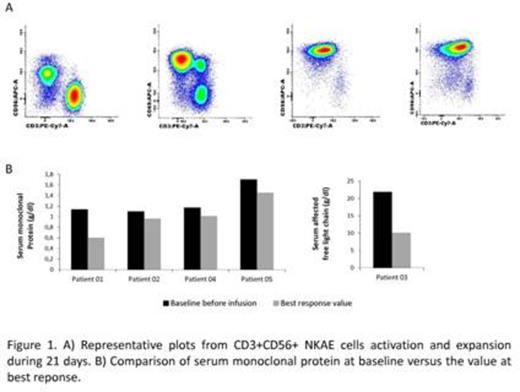Abstract
Multiple myeloma (MM) remains an incurable disease, despite that it has had a huge increase in survival in part due to new drugs as proteasome inhibitors and immunomodulatory drugs; however new therapeutic venues are required. Immune-based therapies are having an important relevance to control cancer, and are a new therapeutic armamentarium. Natural killer (NK) cells have an important role as natural control of tumor cells; based on that, NK cell infusions could be a novel treatment strategy to treat MM. By co-culture with the genetically modified cell line K562-mb15-41BBL it is possible to expand ex vivo large numbers of activated NK (NKAE) cells from MM patients. NK cell therapy has some challenges to be answered in real clinical practice: Could they be used out of transplantation setting? Could they be used with other anti-myeloma drugs? Could they be infused and expanded several times? To answer these questions we have designed a phase I clinical trial to make multiple infusions of autologous NKAE cells together with anti-myeloma drugs bortezomib or lenalidomide in MM (NCT02481934).
Five MM patients on 2nd or later relapse have been enrolled in this phase I clinical trial to date. To activate and expand NK cell, peripheral blood mononuclear cell (PBMCs) were co-cultured with K562-mb15-41BBL cells and 100 IU/ml IL-2. We collected 200 ml of peripheral blood (PB) from patients every cycle (n=4) to produce autologous NKAEs under GMP conditions and cells were harvested on day 14 and 21 for infusions. Four cycles of pharmacological treatment with 2 infusions of 7.5x106 autologous NKAEs/kg on day 1 and 8 of each cycle were performed. NKAEs purity and T regulatory cells (Treg) were analyzed by flow cytometry. NK cells presence in PB was also assessed by PB smear examination before and after each infusion. Serum cytokines concentration was determined by cytometric bead assay. Safety of NKAE end products was verified by real time-PCR of c-MYC and telomerase on NKAE from the 2th and 3rd week of expansion. BCR-ABL PCR studies were performed on NKAE cultures and on PB samples from the patients after treatment.
Three patients received lenalidomide-based treatment and 2 bortezomib-based treatment. Patients received a total of 35 NKAEs infusions. We have not observed any serious toxicity attributable to NKAE infusion. Two patients had grade II neutropenia, which did not require dose adjustment. The 5 MM patients enrolled had 23% (±11%) NK cells of PBMCs. We collected a mean of 21x106 NK cells from PB. After 1 week NKAEs number increased x13 with 71% of NKAEs, at 2nd week the fold of NKAE cells expansion was x30 with a purity of 92%. We collected 550x106 (±50x106) NKAEs from culture for the first infusion. At 3rd week NKAEs number increased 45 times (fig.1.A). NKAEs infusion was completely safe; expression of c-Myc and telomerase was not altered in NKAE end products. The expression of BCR-ABL disappeared from cultures after the first week, and was undetectable in PB after NKAE therapy. Contamination of autologous T cells on NKAE end products was not significant; less than 4%.
NKAE cells were detectable on PB after infusions; percentage of PB NK cells increased a mean of 5% and expression of activatory receptors NKp30 and NKG2D and apoptosis ligands TRAIL and FasL increased on PBMCs after infusion. PB smear showed an increase fold of activated circulating lymphocytes change of x3.8 (p<0.05). There was no variation on Treg CD4+CD25+CD127- during therapy. Serum levels of IFN-γ increased progressively until the 7th day of cycle and IL-10 levels showed an increase at the end of cycle.
Patient 01 achieved a partial response and maintained it for 13 months after NKAEs infusion. Patient 02 started NKAEs infusion while in relapse and, achieved stable disease, which was maintained for 9 months before disease progression. Of note, bone marrow infiltration by MM plasma cells decreased at least 50% at the end of NKAE treatment in these two patients. Patient 03 had disease progression 2 months after stopping treatment due to unrelated toxicity. Patients 04 and 05 recently finished NKAEs treatment and achieved disease stabilization 4 months after the first NKAE infusion (fig.1.B).
Clinical-grade NKAEs can be obtained from MM patients undergoing treatment, and multiple infusions of NKAEs are feasible without toxicity. NKAEs showed clinical anti-myeloma activity. These results warrant further development of NKAEs infusion as a treatment modality for MM.
Lahuerta:Janssen Cilag, Celgene: Honoraria, Membership on an entity's Board of Directors or advisory committees.
Author notes
Asterisk with author names denotes non-ASH members.


This feature is available to Subscribers Only
Sign In or Create an Account Close Modal